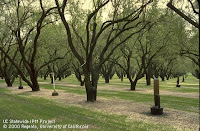Orchard tasks to help prevent frost damage

A light frost event is predicted for Tuesday and Wednesday night. Last year, an unexpected frost event caused a lot of damage to almonds throughout the San Joaquin Valley. Today's entry will focus on frost protection.
Types of frost. There are two major types of frost events that occur throughout California. An advection frost occurs when a cold front moves into the region, displacing the warm air. These events are rare and will have temperatures dropping below freezing even though the it may windy. They are very difficult to protect against due to the rapid displacement of heat from the orchard. Radiation frosts are more common. They are characterized by clear skies, calm winds, and temperature inversions. These frost events occur due to the gradual loss of heat from the orchard.
Almond Susceptibility to Frost.
Generally speaking, the further the tree advances out of dormancy, the more sensitive to frost it becomes. A dormant tree is very tolerant to cold temperatures, while small nutlets are very sensitive to frost damage. At this point of the growing season - petal fall to early nutlet development - temperatures below 26F will cause significant to total loss of the almond crop, while temperatures above 28F will cause minimal damage to the crop. The small difference of 2F makes the difference, and is why frost prevention strategies can be used to reduce crop loss.
Frost damage prevention.
Assuming that the orchard has already been planted (Further information regarding site selection for frost prevention can be found in the UC Almond Production Manual), Growers can manage their soil moisture and ground cover to help reduce frost damage from a radiation frost event. Moisture within the soil retains heat. This heat is then radiated up into the trees during a cold night. Dry or cultivated soil usually holds less moisture due to loss by evaporation, thus making the orchard more susceptible to frost. Ground cover pulls this moisture from the soil AND prevents the heat from rising to the boundary layer of the almond tree. Therefore, ground covers should be mowed to a low level to reduce the chance of frost on a cold night. Irrigating the surface soil should be done in anticipation of a frost event. Re-wet as needed.
Active frost protection can be utilized by introducing air movement or heat. At one time heaters were widely used to prevent frosts. Most heaters have been banned due to pollution concerns by the CA air resource board. Check with your local ARB for an updated list. Wind machines and Helicopters have also been employed to bring heat into the orchard. Commonly used in citrus orchards, wind movement introduces warm air - usually from the inversion layer - into the orchard.
The use of microsprinklers and solid-set sprinklers typically provide the best, affordable form of frost protection. Upon the orchard temperature dropping, sprinkler irrigation systems should be turned on to wet the soil surface. This wetting prevents the soil surface from dropping below 32F, and provides radiant heat for the orchard. In some cases, applications of water by solid set sprinklers have provided temperatures that were 4F to 5F six feet above the ground. Within microsprinklers,enough water must be used to provide adequate and consistent wetting of the soil surface. For most microspinkler systems, the exception be low volume sytems, this means to just turn them on.
Make sure to check your irrigation pumps to ensure that they will start up when needed. No one wants to be caught out working a pump at 3:00 AM when the temperatures are below freezing.
Also keep in mind that the actual temperature may be colder in the orchard than predicted - sometimes up to 2-3F difference. Therefore, frost protection measures should be utilized when temperatures drop to 30F.
More information regarding frost protection can be found in the UC Almond Production Manual.
